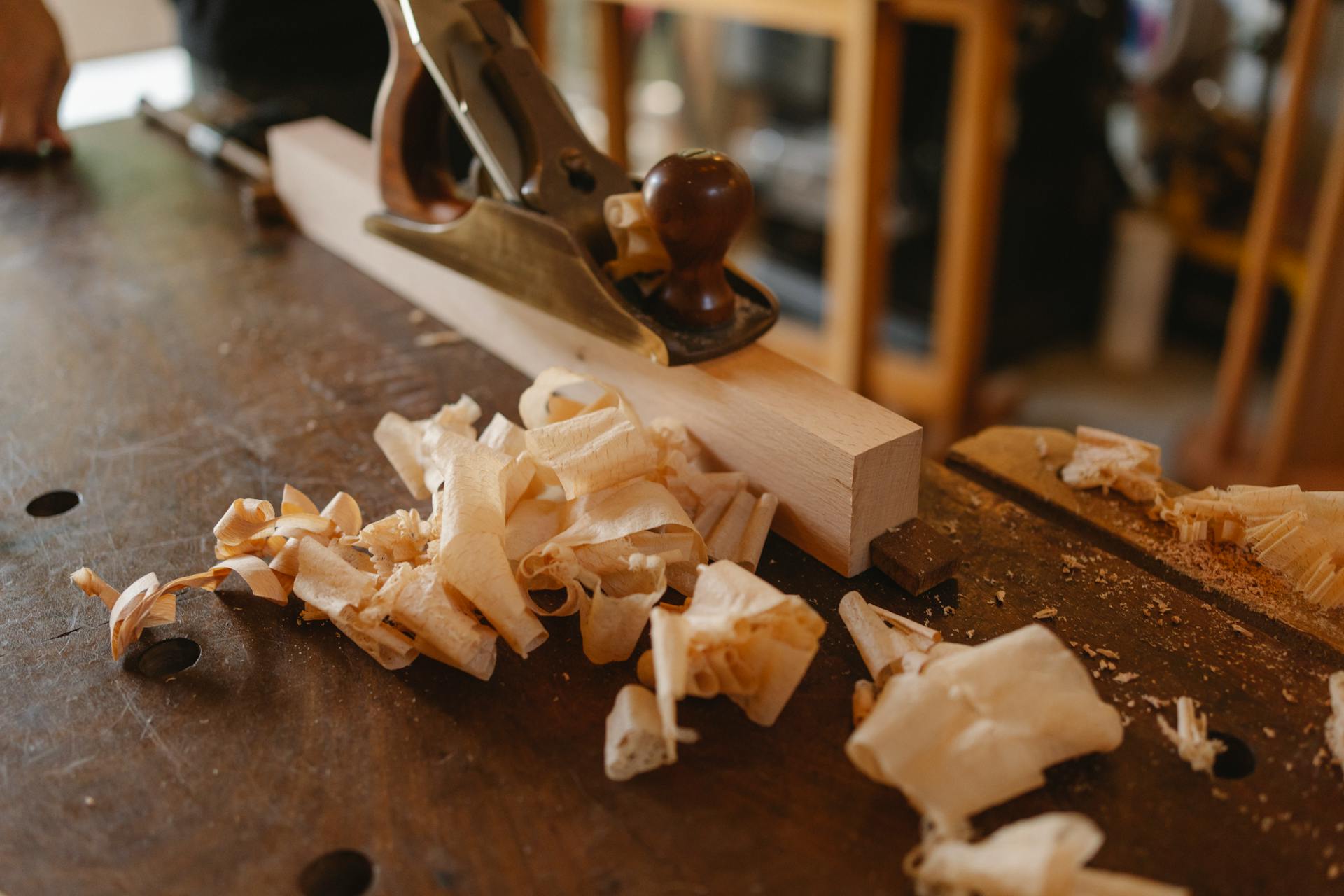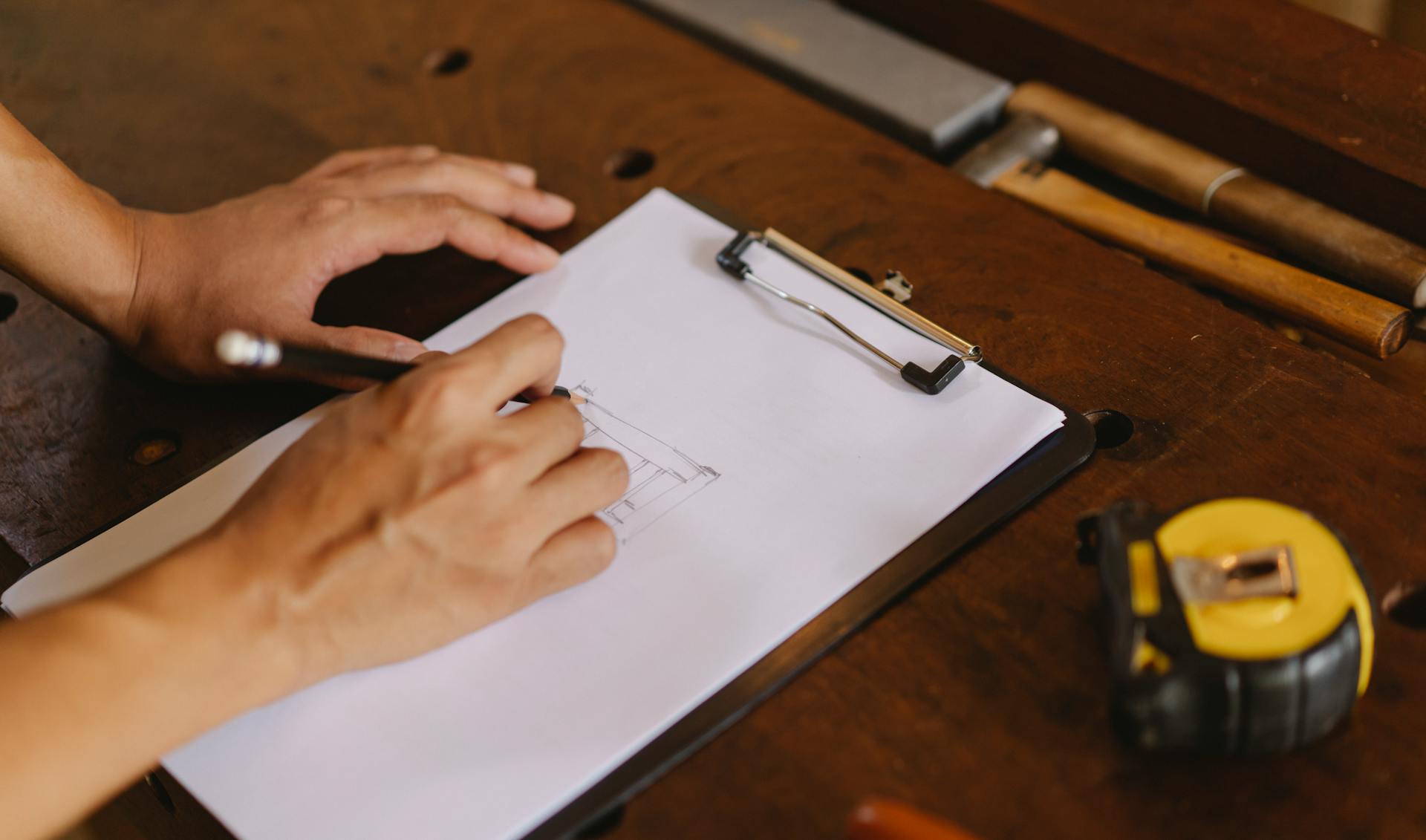
High-quality wood can bring a touch of elegance and sophistication to any project or design. Its benefits are numerous, ranging from increased durability and longevity to improved aesthetics and overall appeal. Whether you're constructing a new home, updating your existing furniture or simply looking for a stunning addition to your decor, high-quality wood is an excellent choice.
For instance, the South Haven Remembrance Center in Michigan features beautiful wooden accents that enhance its peaceful atmosphere. Similarly, the Canada photo captured by Ema Peter Photography showcases the natural beauty of wood in all its glory. In a quick summary, it's impossible to overstate the advantages of using high-quality wood in any context.
A different take: High Tech Green Building Solutions
Quick Summary:

Delta Millworks is an industry leader in sustainable wood products, offering a greatly expanded product line that includes exterior cladding, interior paneling, decking, and flooring. Delta's clean and high-quality products have outstanding versatility and are in high demand inside the United States. They specialize in using reclaimed wood salvaged from tree farms and old-growth forests and accomplish their manufacturing processes naturally, without the use of harsh chemicals that can adversely affect human health or pollute landfills.
Delta's core business philosophy is to build sustainably by making beautiful products that are both environmentally friendly and aesthetically pleasing. The company is a pioneering purveyor of revolutionary treatments that preserve the natural beauty of wood while also extending its lifespan. Their high-quality wood can be found in upscale hotels, tech headquarters, residential homes, and construction projects run across the gamut.
The company's second-generation leader and CEO Robbie Davis continues to expand on the founding father Bob Davis' vision for sustainable wood products. Delta Millworks' diverse product offering includes exterior cladding, interior paneling, decking, and flooring - all accomplished using time-tested techniques that honor the unique character of each piece of wood they work with.
On a similar theme: Sustainable High Rise Buildings
Disadvantages Of Manufactured Wood
While manufactured wood may be a cheaper alternative to solid wood, there are potential downsides that should be taken into consideration. One of the frequent concerns is its structural weakness susceptibility. Unlike solid wood, manufactured woods can easily crack or break under pressure due to their lower density and strength.
Another potential downside of manufactured woods is their potential health hazards. The adhesives and chemicals used in the manufacturing process can emit volatile organic compounds (VOCs), which can cause respiratory problems and other potential health risks. It is important to ensure proper ventilation during woodworking projects involving manufactured wood.
In conclusion, while there are benefits to using manufactured wood in woodworking projects, it is crucial to consider the potential downsides. Structural weakness compared to solid wood and potential health hazards are just two of the many factors that should be taken into account when deciding whether or not to use this type of material in your projects.
A fresh viewpoint: Know about Reclaimed Wood
1. Structural weakness compared to solid wood
When comparing structural integrity, solid wood has the advantage over manufactured wood materials. While combining manufactured and solid wood components can offer enhanced strength, the big drawback of manufactured wood items is their susceptibility to severe loads. To compensate for this weakness, supports employing thicker panels entail adding to the cost of the exact product. Overall, high quality solid wood remains a top choice for its durability and reliability in construction and furniture-making.
2. Susceptibility to moisture and temperature changes
High-quality wood offers many benefits, but one consideration to keep in mind is susceptibility to moisture and temperature changes. Both solid wood and manufactured wood items can absorb moisture from the air, causing warping and swelling, especially in extreme temperature or greater humidity levels. To prevent moisture-related damage, it's essential to correctly seal or finish produced wood goods with water-resistant coatings or laminates. Ensuring proper ventilation and climate control also helps preserve the integrity of wood products.
Discover the Versatile Applications of Manufactured Wood

Manufactured wood is a great alternative to traditional wood types, with many quality features that make it an ideal building material. Unlike real wood types, manufactured woods are made by bonding layers of wood veneers or fibers together. This means that they have a more uniform structure, making them less prone to warping or splitting. Additionally, manufactured woods are great for holding nails and screws, making them a popular choice for construction projects.
In addition to their durability and strength, manufactured woods also have great customization abilities. They can be easily stained or painted to match any interior design style or color scheme. This makes them a popular choice for furniture making as well, where manufacturers can create unique pieces that fit their customers' exact specifications.
Overall, the versatility and quality of manufactured wood make it an attractive option for builders, designers, and homeowners alike. Whether you're looking to build a new home or simply update your furniture collection, this type of wood offers many benefits over traditional options. So take some time to explore the world of manufactured woods and discover all the ways in which they can enhance your next project!
1. Manufactured Wood in Flooring
Manufactured wood flooring, also known as engineered wood, is a popular option due to its great qualities. It is made of multiple layers of wood panels in crosswire direction, which makes it considerably high quality grade manufactured wood. Improvements in the manufacturing process have made it a trending wood flooring option that lasts long easily and can be easily painted. More importantly, manufactured wood is cheaper and more environmentally friendly than solid woods, making it the perfect choice for those who want high-quality wood flooring without ruining their budget or the environment.
2. Manufactured Wood in Furniture Making
Manufactured wood has become increasingly popular in furniture making, as it offers a cost-effective and eco-friendly alternative to high-quality wood. With day-to-day lives revolving around chairs, desks, cupboards, beds, racks, sofas, and drawers, manufactured wood such as medium density fiberboard (MDF) is widely used due to its workability for screwing and nailing ability. Its smoothness of surface ease with paint make it a go-to choice for indoor and outdoor furniture. While it may not match the quality of traditional wood types, manufactured wood still provides durability and accessibility to those looking for affordable furniture options.
3. Manufactured Wood in Decking
Manufactured wood is a popular choice for outdoor applications, including decking. Treated manufactured wood has good water resistance and can withstand moisture levels in the outdoor environment. Untreated manufactured wood, however, can easily absorb water molecules and quickly degrade, making it unsuitable for outdoor applications. It's important to choose high-quality treated manufactured wood for optimal performance in outdoor applications.
Everything You Need to Know About Manufactured Wood

Manufactured wood, also known as engineered material made from wood fibers, chips, and veneers combined with adhesives pressed into boards or sheets, offers consistency and uniformity in woodworking projects. Although it has lower structural strength compared to solid wood, common types include plywood, MDF, particleboard, OSB, and veneer wood.
A-grade high-quality manufactured wood is a great alternative to solid wood for many reasons. It is affordable because it uses waste materials from the lumber manufacturing process. It is also more stable than solid wood since it does not expand or contract with temperature changes like natural timber. Lastly, manufactured wood can be customized by adding finishes or veneers that give it a look and feel similar to high-end solid wood.
Now that I've answered some frequently asked questions about manufactured wood, I highly recommend giving this engineered material a try on your next woodworking project. With good research and careful selection of the right type of manufactured wood for your needs, you can achieve the same look and durability as solid wood at a fraction of the cost.
1. Leave a Comment
"Leave a Comment" section is a great way to share your thoughts and experiences on the benefits of high-quality wood. Whether it's the durability, aesthetic appeal, or sustainability, there are countless reasons why investing in high-quality wood is worth it. So don't hesitate to leave your comment and join the conversation about the wonders of wood!
Discovering Different Varieties of Manufactured Wood

If you're looking for a cost-effective and eco-friendly alternative to traditional hardwood, then manufactured wood types are worth exploring. There are several popular types of manufactured wood such as Medium Density Fiberboard (MDF), Laminated Board, Veneer Wood, and Oriented Strand Board (OSB). These woods provide an opportunity to save money without compromising on quality.
Medium Density Fiberboard (MDF) is made by compressing sawdust and resin together. It's smooth, durable and is an excellent option for furniture-making. Laminated board, also known as particleboard or chipboard, is a type of manufactured wood that's made from wood chips or shavings. It's affordable and can be used for construction purposes such as shelving or subflooring. Veneer wood is another type of manufactured wood that uses thin slices of high-quality hardwood glued onto a substrate. It’s great if you want the look of expensive timber without spending much.
Lastly, Oriented Strand Board (OSB) is made from strands of compressed wood mixed with adhesive. This type of engineered wood is strong and durable which makes it perfect for construction projects like flooring systems or roofing sheathing. Now that we’ve discussed some popular types let’s delve deeper into the different varieties of manufactured woods available in the market. By knowing these options, you’ll be able to make informed decisions when purchasing materials for your home projects while saving money at the same time!
Readers also liked: Benefits of Construction Management Software
1. Particleboard or Chipboard
When it comes to manufactured wood, let's talk about the differences between particleboard and chipboard. Particleboard is an inexpensive, low-density flat board made by combining wood chips and sawdust. It is an affordable manufactured wood product that has become a popular option for low-cost manufacturing by woodworkers. While it may have a rougher surface and lower strength compared to chipboard, its minimal moisture exposure makes it suitable for non-structural applications such as wall paneling or false ceiling core material. Its low cost makes it an attractive option for those with budget constraints where price is the primary concern.
2. Veneer wood
Wood veneer refers to thin slices of natural wood that are used to cover core panels made of chipboard MDF or other manufactured wood products. Veneered products showcase beautiful wood grain patterns, allowing for the use of exotic wood species in high-end cabinetry and furniture making. While solid wood is often preferred, veneer wood can provide lasting results if proper surface preparation is ensured before application of the decorative layer peeled from logs.
3. Oriented Strand Board (OSB)
Oriented Strand Board (OSB) is a sturdy manufactured wood product made from utilizing small fast-growing trees and wood waste. OSB boasts impressive strength and rigidity, making it a popular choice for structural applications in building construction. While it shares some similarities with plywood, OSB has a rougher surface and is typically recommended for wall sheathing, subflooring, and other non-high-end cabinetry uses. Plus, it's environmentally friendly!
Can I achieve a high-quality finish on manufactured wood?
Can I achieve a high-quality finish on manufactured wood? Absolutely. While it may not have the same natural grain and character as solid wood, manufactured wood can still be transformed into a professional-looking finish with the right techniques.
The key to achieving a polished look on manufactured wood is in the finishing techniques. Sanding and sealing the surface is crucial for creating an even base, while using thin slices of real wood can add texture and depth to the finished product. Applying clear topcoats will protect the surface while enhancing its shine, resulting in a beautiful final result that rivals even solid wood finishes.
Expert Tricks for Handling Manufactured Wood

Manufactured wood, also known as composite wood, is a popular alternative to solid wood due to its affordability and versatility. However, working with this type of material can present some challenges. To achieve excellent results when cutting, shaping, and joining manufactured wood, there are a few helpful tips you can follow.
Firstly, it's important to choose the right cutting tools for the job. Because manufactured wood can be more brittle than solid wood, using a saw or blade that is too aggressive can cause splintering or chipping. Secondly, finishing manufactured wood ensures that it looks just as good as solid wood once it's completed. Sanding the surface thoroughly before applying any finishes will help ensure an even and polished appearance. By following these expert tricks for handling manufactured wood, you'll be able to create beautiful projects with confidence!
1. Cutting and shaping techniques Of Manufactured Wood
To achieve precise clean cuts on manufactured wood products, it is important to use sharp high-quality cutting tools such as carbide-tipped blades. When making straight cuts, ensure that the good side is facing up and apply masking tape along the cutting line to prevent chipping. For jigsaw cuts, a fine-toothed blade is recommended while curved cuts can be made with a spiral bit. To create profiles, use a sanding block for smoothing edges and minimize tear-out on the visible surface.
2. Joinery methods for manufactured wood
Joinery methods for manufactured wood are crucial to achieve sturdy joints and added strength. To create strong connections, it's important to use specialized hardware such as pocket-hole screws or confirmat screws designed specifically for manufactured wood products. It's also important to drill pilot holes and properly align the pieces before applying glue to prevent splitting and reinforce joints. When working with manufactured wood, mistakes can be avoided by ensuring sufficient holding power without overtightening screws.
Frequently Asked Questions
What Woods go well with other woods?
When pairing woods together, it's important to consider the undertones of each wood. Woods with warm undertones such as cherry and mahogany, pair well with other warm-toned woods like oak and maple, while cool-toned woods like walnut and ash pair well with each other.
Can you pair woods with prominent grains?
Yes, you can pair woods with prominent grains, but it's important to balance the grains so they don't clash with one another. Consider using contrasting colors or textures to create a harmonious look.
Which wood should dominate?
There is no one wood that should dominate; it depends on your personal preference, the purpose of the wood, and the environment it will be in. Consider factors such as durability, sustainability, cost, and aesthetics before making a decision.
What color goes with natural wood?
Neutral colors such as white, beige, gray and black go well with natural wood. These colors create a balanced and harmonious look that enhances the beauty of the wood.
Is wood good for your health?
Wood is a natural and renewable resource that can have positive effects on mental health by reducing stress and improving overall well-being. However, certain types of wood may release harmful toxins, so it's important to choose non-toxic options.
Featured Images: pexels.com


